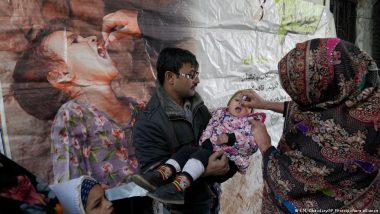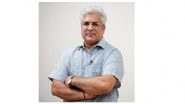Last month, Pakistan reported its fifth case of the deadly virus. Experts explain that large population movements and "significant vaccine hesitancy" is hindering progress in combating polio.Pakistan's polio eradication campaign is in disarray after the South Asian country of 240 million people reported the year's fifth case of the highly infectious virus. It is another blow to the country's efforts to eradicate the debilitating disease.
Also Read | Germany’s Habeck Navigates Delicate China Mission.
Four polio cases were reported in the southwestern Balochistan province bordering Afghanistan while a fifth case is the latest to be reported from the southern Sindh province concerns about the feasibility of eradicating polio in the near future.
Also Read | Alki David, Coca-Cola's Heir, Ordered by Los Angeles Jury To Pay USD 900 Million to Women Who Accused Him of Sexual Assault and Harassment.
Malik Mukhtar Bharath, the prime minister Shehbaz Sharif's coordinator on national health services, said: "The cases this year are a striking reminder that no child anywhere would be totally safe from the crippling disease until Pakistan succeeded in eradicating polio completely."
According to the World Health Organization, polio, which is found typically in children under the age of 5 and can lead to paralysis or even death, remains endemic in two countries — Afghanistan and Pakistan.
Last year six cases of the virus were detected in Pakistan. According to the Global Polio Eradication Initiative (GPEI), Pakistan was tantalizingly close to the elimination of polio after just one case was reported in 2021.
Conspiracy theories hinder progress
Experts believe that the cases emerging in Pakistan are due to various factors.
"Pakistan and Afghanistan continue to operate in a highly complex and challenging environment," Dr Hamid Jafari, director of polio eradication at the WHO Eastern Mediterranean Region, told DW. "Primary drivers of risks include large population movements, insecurity compromising access and quality of vaccination in key infected areas, combined with communities with significant vaccine hesitancy and persistently low routine immunization coverage in polio-critical geographies."
"All five cases reported this year in Pakistan are linked to the two YB3A related genetic clusters following extensive cross-border transmission from Afghanistan. These cases have been reported from Chaman, Dera Bugti, Kila Abdullah, Shikarpur and Quetta," added Jafari.
The polio workforce is frequently targeted in Pakistan where Islamist militants and hardliner clerics blamed government vaccination drives as a foreign agenda to sterilize Muslim children and a cover for Western spies.
"The current widespread detections are especially concerning as we have just now entered the high transmission season. The virus has been reestablished in our historic reservoirs. From there it is spreading. We can expect more spread over this high transmission season," Natalia Molodecky, who worked with GPEI in Pakistan's polio emergency operations center in Islamabad, told DW.
"The main factor attributed to large unpredictable movements of populations resulting in virus detection in areas that had been polio-free for years. The large unusual population movements were in part related to the repatriation of Afghan migrants," underlined Jafari.
However the five cases reported are not clustered and are reported from five different districts of two provinces.
"Natural disasters including torrential rains, heat waves, and flooding create a snowball effect where internal displacement results in low vaccine uptake while poor sewage allows entry of polio virus in the water reservoirs. Lack of clean drinking water forces people to drink unhygienic water, increasing the risks," Dr Fareeha Irfan, a public health physician and expert in policy working with the Punjab healthcare commission, told DW.
Sporadic cases 'likely' to continue
Experts warned that there could be a spike in polio cases ahead and the risks of the virus resurging in high-risk areas is real.
"The persistent detection of poliovirus in environmental samples and sporadic cases will delay the interruption of transmission beyond the timeline of end 2024, and will likely get pushed to the next low season in the first half of 2025," asserted Jafari.
Molodecky agrees with Jafari. "As polio continues to move out of the core reservoirs during this high transmission season, we may see an increased case burden outside of these historic reservoir areas," the health expert said.
Despite a remarkable progress in the global effort to eradicate the crippling virus, both Pakistan and Afghanistan continue to combat sporadic outbreaks, particularly in remote regions with disrupted access to healthcare services.
"The program in Pakistan has reached a high level of sophistication and possesses the resilience, capabilities, resources and support needed to finish the job," affirmed Jafari.
Diversion of resources, human and infrastructural, to matters deemed more important have been responsible in the past for an uptick in polio cases.
"Vaccine hesitancy always underscores a suboptimal uptake of vaccines in Pakistan, and while the trend was limited to a less educated strata of the society, now even educated families are reluctant to get their children vaccinated, especially with oral vaccines," said Dr Irfan.
How to tackle it?
Experts suggest that urgent and diligent work to end polio must continue throughout this year to carefully identify and remap migrants and all unvaccinated children.
"We must ensure these missed children are vaccinated to stem outbreaks and ensure historic reservoirs, the major population hubs that were free of polio for more than two years, stop the virus as soon as possible," suggested Jafari.
The pattern of virus detections strongly suggests that populations living in bordering districts are contributing to the persistence and spread of the virus.
"When we are talking about sources versus sinks of virus — the source of virus is typically our historic reservoirs — so tackling things at the source is critical for sustained success. We know how to clear polio from these areas and have done it before," underlined Molodecky.
"Greater coordination and collaboration of efforts along border areas of Afghanistan and Pakistan, known as 'virus corridors,' is essential in the coming months," stressed Jafari.
Edited by: John Silk
Before you leave: Every Friday, the DW Asia newsletter delivers compelling articles and videos from around the continent right to your inbox. Subscribe below.
(The above story first appeared on LatestLY on Jun 20, 2024 09:30 PM IST. For more news and updates on politics, world, sports, entertainment and lifestyle, log on to our website latestly.com).















 Quickly
Quickly






















